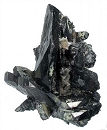
|
| Ferberite |
Chemical
Formula |
FeWO4 |
Species |
Molybdates & Tungstates |
Crystal
System |
Monoclinic |
Mohs
Scale |
4 |
Specific
Gravity |
7.6 |
Color |
Black; dark brown in transmitted light |
Streak |
Brownish black to black |
Luster |
Adamantine, Metallic, Sub-Metallic |
Refractive
Index |
n = 2.255 n = 2.305 n = 2.414 |
Diaphaneity |
Opaque |
Cleavage |
PerfectPerfect on |
Fracture |
Irregular/Uneven |
| Crystal Habit:Crystals wedge-shaped, commonly flattened and elongated or, less commonly, along . Crystal faces striated parallel or ; as groups of bladed crystals; less often short prismatic [001] and flattened {100}. Massive. |
| Geological Setting:High temperature hydrothermal veins, greisens, granitic pegmatites. |
Ferberite is the iron endmember of the manganese - iron wolframite solid solution series. The manganese endmember is hübnerite. Ferberite is a black monoclinic mineral composed of iron(II) tungstate, FeWO
4.
Ferberite occurs as granular masses and as slender prismatic crystals. It has a Mohs hardness of 4.5 and a specific gravity of 7.4 to 7.5. Ferberite typically occurs in pegmatites, granitic greisens, and high temperature hydrothermal deposits. It is a minor ore of tungsten.
Ferberite was discovered in 1863 in Sierra Almagrera, Spain, and named after Moritz Rudolph Ferber (1805-1875).


 YueGongAnBei 44051102000467
YueGongAnBei 44051102000467


 |
|